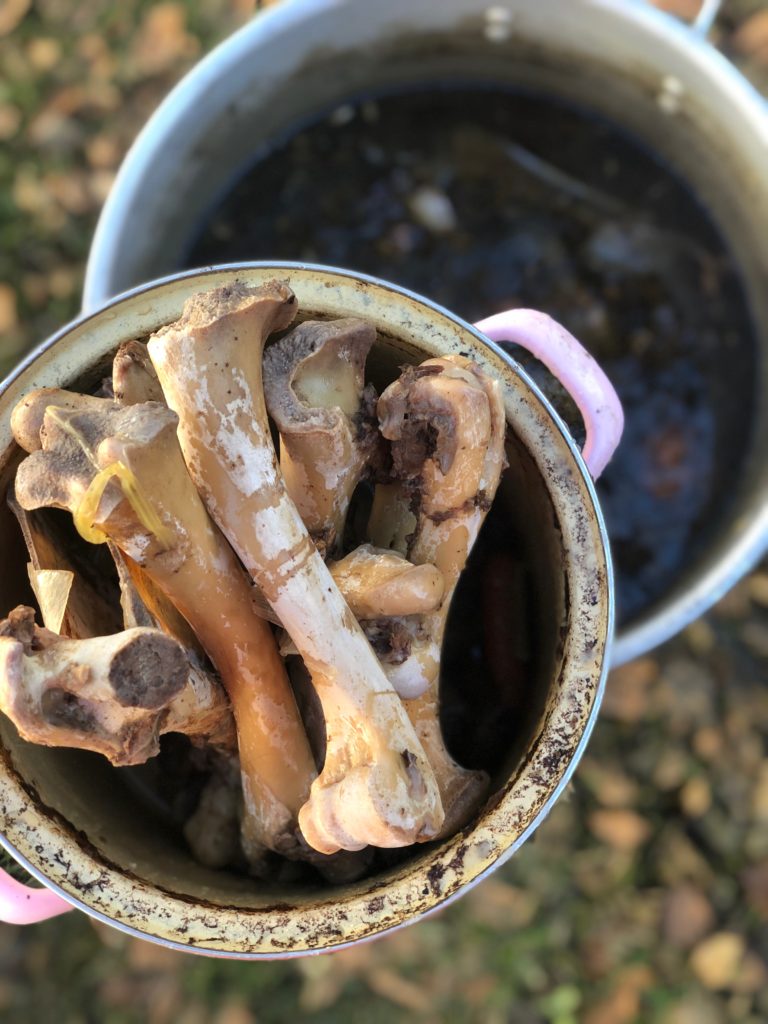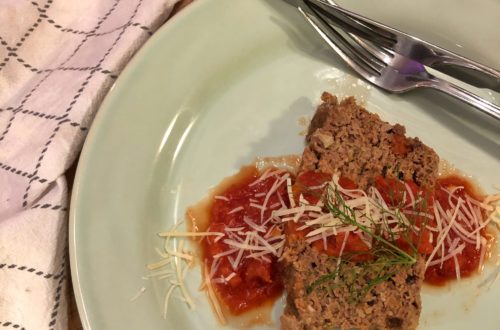
Make the Most of It: A Comprehensive Guide to Making Wild Game Stock
Stock is everything in cooking. Without it, nothing can be done. If one’s stock is good, what remains of the work is easy; if, on the other hand, it is bad or merely mediocre, it is quite hopeless to expect anything approaching a satisfactory result.
—Auguste Escoffier, Le Guide Culinaire
Stock is the backbone of good cooking.
—Anthony Bourdian, Kitchen Confidential
I keep an inventory taped to the refrigerator of my current frozen possibilities. There are two shelves of favorites—rabbit, grouse, woodcock, snipe, venison, dove, chukar, duck, quail—and containers of fish fumet, various glacés, and stocks, including one made from 16 woodcocks that deserves its own armed guard.”
—Jim Harrison, Sporting Food
Well-made stock is the foundation upon which good cooking is built. Using stock that you carefully made yourself, as opposed to the store-bought variety, has the power to elevate your cooking and transform your food from mundane to magnificent. Enjoy one spoonful of wild turkey soup made with homemade broth or one sip of well-seasoned, collagen rich pork stock made from wild boar bones several days simmered, and you’ll know exactly what I mean.
As hunter’s, we’re lucky to have access to bones. Lots of them. I never toss bones in the trash. When my work at the butcher block is complete, I always make a big batch of stock for the freezer. It’s just too easy and too important not to do.
Why make stock at home?
Well-made stock is something that you simply cannot buy in the store. You have to make it home, and the end result will be orders of magnitude better than the stuff you’ve seen on grocery store shelves. In addition to yielding a high quality product, stock making comes with the added benefit of satisfaction.
While the stock from your latest hunting adventure is simmering on the stove top for hours on end, you’ll be able to sit back and revel in the fact that you are putting every last bit of the valuable resource you harvested to good use.

What is stock?
Stock is very simple. In its most basic form, it is just a concentrated, flavorful liquid made from boiling and then gently simmering bones for a long, sustained period of time. Usually, in addition to bones, stock making requires a mixture of vegetables (mirepoix), spices, aromatics and water.
It can be used as the basis for soups, stews, sauces, and gravies, and it is great to have on hand for braising tougher cuts of meat for long periods of time in the oven or on the stove top.

Stock vs. Broth
There seems to be a lot of confusion around the difference between stock and broth, and I have to admit, before researching and writing this article I really didn’t know the difference between the two. While the two terms are usually used interchangeably, the essential differences amount to what’s on the bone.
A truce stock should be made from bones that are primarily devoid of meat, while broth is made from a mixture of meat and bones. Personally, I try not to get caught up in the culinary weeds here. If the bones I’m using to make stock still have some lingering meat attached, left over from the butchering process, so be it. Usually the stock comes out hardier and tastier as a result. Call it what you want.

Usually, if a recipe calls for broth, I won’t hesitate to use stock. The only thing I’m careful to adhere to is the species of animal from which the stock is supposed to be made. If a recipe calls for chicken broth and I happen to have some wild turkey stock on hand, I’ll use it. If a braise or a stew calls for 2 cups of beef broth, I’m using venison stock every time.
Blonde Stock vs. Brown Stock
There are two categories of stock you will often see batted around in culinary circles—blonde and brown. The difference between the two is simply a matter of preparation. Brown stock refers to stock made with bones that have been roasted beforehand, while blonde stock refers to stock made from fresh, raw bones that weren’t roasted off before simmering.
As a rule of thumb, brown stock is usually made from the bones of four-legged, hoofed critters like cows, pigs, deer, muskox, New Zealand Thar (you get the picture), while the blonde stock preparation is primarily reserved for feathered quarry and seafood. That’s not to say you can’t make brown stock from bird bones. You can, and I often do.

There are also times when beef, pork or venison bones should be kept raw and not roasted. For example, the Vietnamese tend not to roast the beef bones that they commonly use to make stock for Pho. As anyone who’s had a good bowl of Pho will tell you, it is one of the world’s greatest soups, and when it comes to Pho, the stock is undoubtedly the star of the show.
Storing your Stock
Fresh
Fresh is always best, wether you’re talking stock or wild game meat itself. After a successful whitetail season, I always try to make as many dished as I can with fresh stock before the rest in inevitably frozen for the winter months to come.
Frozen
I usually freeze the remaining stock in quart ziplock bags or plastic 1 quart deli containers. One quart seems to be a good size to pull from the freezer and use for individual recipes. Note: steer clear of freezing your stock in glass. I cracked many a mason jar before I learned this lesson the hard way.
Pressure Canned
In don’t have any experience with this methods, but it is a good alternative when freezer space is limited. Pressure canning is a tutorial unto itself that I hope to explore more and write about in the future.
How to Make Stock
To make a basic stock you’ll need bones, water, a mix of veggies—usually equal parts carrots, celery and onion—and some spices, seasonings and aromatics of your choosing.
Mirepoix
Mirepoix is a fancy french culinary term that you’ll sometimes see in recipes. It just means a mixture of chopped veggies.
My go-to veggies amount to a basic mirepoix of equal parts carrots, onions and celery. You can adjust this to your liking. For venison, some folks like to add parsnips for sweetness.
Other Seasonings and Spices
For a basic broth I will also add salt, pepper, an aromatic like bay leaves and some type of herb, usually parsley. Again, this simple seasoning bill can be adjusted, added to or detracted from according to your own tastes. That’s the beautiful thing about making stock. There are no hard or fast rules when it comes to the ingredients (beyond the bones of course).
How to Make a Simple Brown Stock
Brown stock is a great place to start if you’re just beginning what will undoubtedly become a life-long love affair with good stock.
- Begin by placing your bones on a sheet tray. I like to drizzle the bones with olive oil, apply a liberal application of salt, and then set them in a 400 degree oven for about an your. These may just be bones, but roasting them for an hour with salt and olive oil will fill your home an amazing aroma, and it will ultimately give you a darker, richer finished stock.
- Once the bones are roasted, use tongs to transfer them to a large stock pot, and fill the pot with enough cold water to completely submerge all the bones.
- Gradually bring the contents to a boil, taking care to skim off any of the scum that rises to the surface.
- Now reduce the heat to a soft simmer. This is important. You do not want a rolling boil here, but a soft simmer on low heat. Over boiled stock can become cloudy and bitter.
- You will need to maintain this simmer, just bones and water at this point, for at least four hours if not longer. I usually let this go overnight.
- Now roast off your chopped veggies the same way you did with the bones, with salt, pepper and olive oil. No need to go a full hour here. Twenty minutes or so will suffice. Note: When chopping veggies for stock it is totally acceptable to use offs and ends that you might otherwise discard or compost—the but end of a onion for example, or the leafy green tops of carrots or parsnips.
- Add the roasted veggies along with the herbs and aromatics to your softly simmering stock for another hour or two. Any longer than that you risk losing the brightness of flavors that these ingredients are meant to impart.
- Strain everything through a fine mesh sieve lined with a paper towel.
- You should be left with a beautiful stock, ready to form the basis of countless recipes to come.




